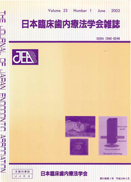17 巻, 2 号
選択された号の論文の13件中1~13を表示しています
- |<
- <
- 1
- >
- >|
総説
-
1996 年 17 巻 2 号 p. 133-139
発行日: 1996年
公開日: 2019/06/30
PDF形式でダウンロード (1368K) -
1996 年 17 巻 2 号 p. 140-150
発行日: 1996年
公開日: 2019/06/30
PDF形式でダウンロード (4781K) -
1996 年 17 巻 2 号 p. 151-161
発行日: 1996年
公開日: 2019/06/30
PDF形式でダウンロード (7851K)
原著
-
1996 年 17 巻 2 号 p. 162-166
発行日: 1996年
公開日: 2019/06/30
PDF形式でダウンロード (4373K) -
1996 年 17 巻 2 号 p. 167-174
発行日: 1996年
公開日: 2019/06/30
PDF形式でダウンロード (6927K) -
1996 年 17 巻 2 号 p. 175-178
発行日: 1996年
公開日: 2019/06/30
PDF形式でダウンロード (2610K) -
Effects of argon laser irradiation with 38% Ag(NH3)2 F on the permeability of root canal wall dentin1996 年 17 巻 2 号 p. 179-184
発行日: 1996年
公開日: 2019/06/30
PDF形式でダウンロード (5090K) -
1996 年 17 巻 2 号 p. 185-189
発行日: 1996年
公開日: 2019/06/30
PDF形式でダウンロード (2764K) -
1996 年 17 巻 2 号 p. 190-196
発行日: 1996年
公開日: 2019/06/30
PDF形式でダウンロード (5601K) -
1996 年 17 巻 2 号 p. 197-203
発行日: 1996年
公開日: 2019/06/30
PDF形式でダウンロード (3914K) -
1996 年 17 巻 2 号 p. 204-211
発行日: 1996年
公開日: 2019/06/30
PDF形式でダウンロード (4853K) -
1996 年 17 巻 2 号 p. 212-216
発行日: 1996年
公開日: 2019/06/30
PDF形式でダウンロード (3364K)
メディカルエッセイ
-
1996 年 17 巻 2 号 p. 260-264
発行日: 1996年
公開日: 2019/06/30
PDF形式でダウンロード (2628K)
- |<
- <
- 1
- >
- >|
